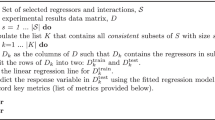Abstract
Taguchi’s loss function has been used for optimal tolerance design, but the traditional quadratic quality loss function is inappropriate in the tolerance design of hierarchical products, which are ubiquitous in industrial production. This study emphasizes hierarchical products and extends the traditional quality loss function on the basis of Taguchi’s quadratic loss function; the modified formulas are subsequently used to establish quality loss function models of the nominal-the-best, larger-the-better, and smaller-the-better characteristics of hierarchical products. An example is presented to demonstrate the application of the extended smaller-the-better characteristic loss function model to the optimal tolerance design of hierarchical products. Furthermore, the problem associated with selecting materials of various grades in the design process is discussed. The results show that the extended quality loss function model demonstrates good operability in the tolerance design of hierarchical products.






Similar content being viewed by others
References
Chan, W. M., Ibrahim, R. N., & Lochert, P. B. (2005). Quality evaluation model using loss functionfor multiple S-type quality characteristics. The International Journal Advanced Manufacturing Technology, 26(1–2), 98–101.
Chen, C. H., & Chou, C. Y. (2003). Determining the optimum manufacturing target based on an asymmetric quality loss function. The International Journal Advanced Manufacturing Technology, 21(3), 193–195.
Feng, S. C., Nederbragt, W. W., Kaing, S., & Sriram, R. D. (1999). Incorporating process planning into conceptual design. In Proceedings of the 1999 ASME Design Engineering Technical Conferences (DETC99), vol.4—4th Design for Manufacturing Conference.
Jeang, A. (1998). Tolerance chart optimization for quality and cost. International Journal of Production Research, 36(11), 2969–2983.
Jin, Q., & Liu, S. G. (2013). Research of asymmetric quality loss function with triangular distribution. Advanced Materials Research, 655–657, 2331–2334.
Lazovic, R., & Mijatovic, I. (2012). Modified quadratic loss function for a trivariate response with the exact feasible region for parameters. Journal of Manufacturing Systems, 31(2), 177–183.
Li, M. H. C. (2003). Quality loss functions for the measurement of service quality. The International Journal Advanced Manufacturing Technology, 21(1), 29–37.
Li, M. H. C. (2005). A general model for process-setting with an asymmetrical linear loss function. The International Journal Advanced Manufacturing Technology, 26(11–12), 1317–1322.
Manarvi, I. A., & Juster, N. P. (2004). Framework of an integrated tolerance synthesis model and using FE simulation as a virtual tool for tolerance allocation in assembly design. Journal of Materials Processing Technology, 150(1–2), 182–193.
Peng, H., Jiang, X., Xu, Z., & Liu, X. (2008). Optimal tolerance design for products with correlated characteristics by considering the present worth of quality loss. The International Journal Advanced Manufacturing Technology, 39(1–2), 1–8.
Podolak, I. T., & Roman, A. (2013). Theoretical foundations and experimental results for a hierarchical classifier with overlapping clusters. Computational Intelligence, 29(2), 357–388.
Rafiei, H., Rabbani, M., & Alimardani, M. (2013). Novel bi-level hierarchical production planning in hybrid MTS/MTO production contexts. International Journal of Production Research, 51(5), 1331–1346.
Robles, N., & Roy, U. (2004). Optimal tolerance allocation and process-sequence selection incorporating manufacturing capacities and quality issues. Journal of Manufacturing Systems, 23(2), 127–133.
Rout, B. K., & Mittal, R. K. (2006). Tolerance design of robot parameters using Taguchi method. Mechanical Systems and Signal Processing, 20(8), 1832–1852.
Shina, S., Kongsuwon, P., & Chob, B. R. (2010). Development of the parametric tolerance modeling and optimization schemes and cost-effective solutions. European Journal of Operational Research, 207(3), 1728–1741.
Taguchi, G., Chowdhury, S., & Wu, Y. (2005). Taguchi’s quality engineering handbook. Michigan: Wiley.
Wu, F., Dantan, J. Y., Etienne, A., Siadat, A., & Martin, P. (2009). Improved algorithm for tolerance allocation based on Monte Carlo simulation and discrete optimization. Computers and Industrial Engineering, 56(4), 1402–1413.
Yang, C. C., & Naikan, V. N. A. (2003). Optimum tolerance design for complex assemblies using hierarchical interval constraint networks. Computers and Industrial Engineering, 45(3), 511–543.
Author information
Authors and Affiliations
Corresponding author
Rights and permissions
About this article
Cite this article
Zhang, Y., Li, L., Song, M. et al. Optimal tolerance design of hierarchical products based on quality loss function. J Intell Manuf 30, 185–192 (2019). https://doi.org/10.1007/s10845-016-1238-6
Received:
Accepted:
Published:
Issue Date:
DOI: https://doi.org/10.1007/s10845-016-1238-6




